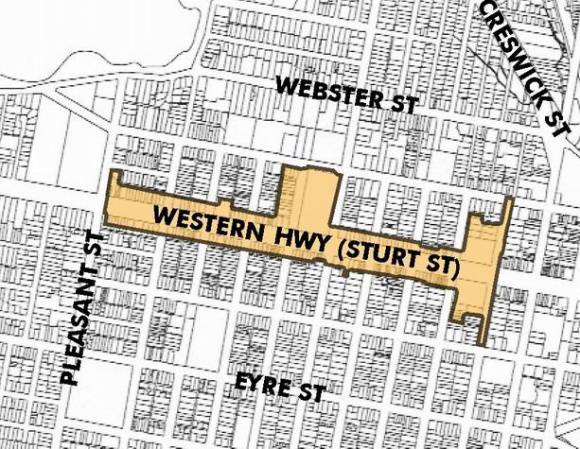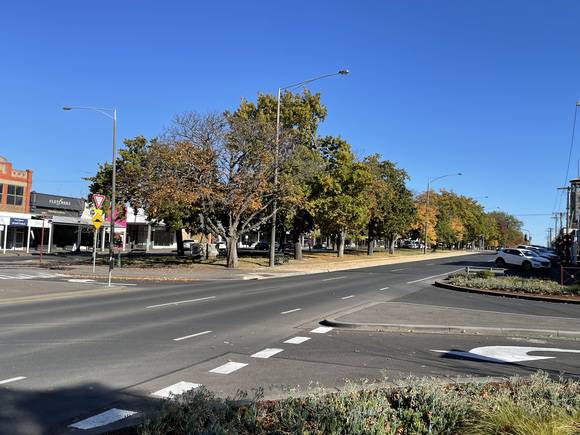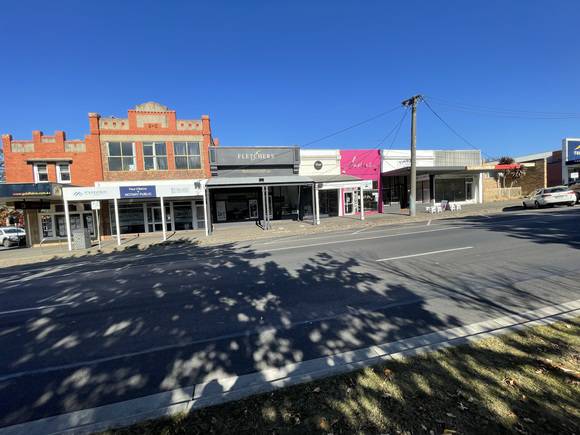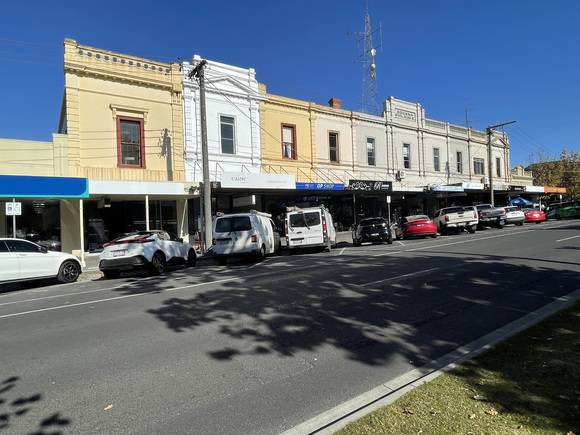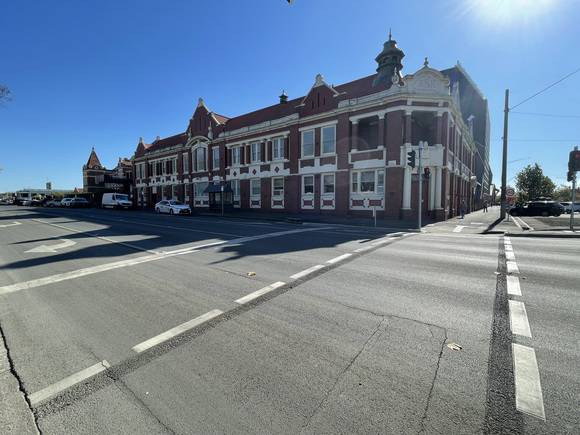| Back to search results » | Back to search page » |
|
Sturt Street Precinct
LocationLevelIncluded in Heritage Overlay |
|
Statement of Significance
What is significant?
How is it significant?
Why is it significant?
The Sturt Street Precinct is historically significant at a LOCAL level. (AHC criteria A3,4 and H.1).
(a) the place's importance in the course, or pattern, of Australia's natural or cultural history;
(a3)importance in exhibiting unusual richness or diversity of built landscapes and cultural features;
(a4) & (h1) importance for association with events, developments, cultural phases and individuals which have had a significant role in the human occupation and evolution of the region.
The Precinct, which mainly focuses on Sturt Street boulevard, is important for its association with William S. Urquhart, the Assistant Colonial Governor Surveyor at the time in 1851, and is an excellent example of the lasting influence of his work. It is historically important for its major contribution to the unified character of Ballarat'surban design that still retains the harmony of its foundation years.
The Precinct is historically important as it shows evidence of the creation of a grand elegant boulevard in the European tradition, within a rectilinear street layout pattern based on hierarchy and axial ordering, a neoclassical planning overlay on a once chaotic gold mining district. The geometric hierarchy was established by predetermined fixed street widths and block sizes that determined the length of streets and scale of intersections that allowed the character of each neighbourhood to change, whilst retaining the visual coherence of the whole.
The Precinct is historically important as it demonstrates the particular social structure of Ballarat during the 19th century which was conducive to a universally admired aesthetic. Sturt Street with its counterpart Victoria Street in East Ballarat, part of the former cattle stock route between Geelong and Adelaide, are the only surveyed roads in Ballarat that were substantially wider and longer than other streets. It was one of the earliest roads to have been surveyed in Ballarat and is important as the central spine of Urquhart's city plan. The Sturt Street boulevard is the focus of city design in this area as the formal western gateway to the centre of the city, and to the east, it links with the commemorative Ballarat Avenue of Honour, where between 1917-1921, over 3,000 trees were planted along the Western Highway for 22km.
The grandeur and scale of Sturt Street moderates the form and structure of the Precinct and provides the setting for many prestigious churches and institutions in the city. In this section of Sturt Street corner sites were reserved for important public buildings. There are three significant early churches of the Catholic, Anglican and Presbyterian faiths, which together with the Ballarat hospital and Fire Station have become hallmark features of the Ballarat vistas and skyline. The residential buildings and two-storey shops demonstrate the development of larger professional and commercial families' houses in the more prosperous western area of Ballarat.
The Sturt Street Heritage Precinct is aesthetically and architecturally significant at a LOCAL level (AHC criteria D.2, E.1, F).
(d) its importance in demonstrating the principal characteristics of: (i) a class of Australia's Cultural places; or (ii) a class of Australia's cultural environments (including way of life, custom, process, land-use, function, design or technique;.
(e) its importance in exhibiting particular aesthetic characteristics valued by a community or cultural group;
(f) its importance in demonstrating a high degree of creative design or artistic excellence, or technical achievement at a particular period.
The Precinct is aesthetically and architecturally significant as a fine example of broad historical townscape founded in 1850s, the product of a European city building tradition. It demonstrates many original and intact urban design and fine architectural qualities associated with the ecclesiastical, civic, commercial and residential development of the Ballarat township between the 1850s and early 1900s.
These important aesthetic and architectural qualities include but are not limited to many local landmarks, such as ecclesiastical and civic buildings and their individual precincts as well as an outstanding collection of residences. Particularly significant examples include a remarkable group of churches. These are the eclectic English Gothic styled former Congregational Church on the corner Dawson and Mair Street, designed by local architects Caselli and Figgis (1881) and Molloy and Chandler (1906 rear additions), the English Norman styled St Andrew Kirk corner Sturt and Dawson Streets designed by local architects C.D. Cutherbert (nave 1862-64), C.D.Figgis (spire 1884) Figgis and Molloy (transept 1889), the English Gothic styled Roman Catholic St Patricks Cathedral located on the opposite corner of Sturt Street, designed by English architects Hansom brothers (1857 and modified by local architects Shaw and Dowden (1857) J.B. Denny (1870) and Melbourne architects Reed Smart and Tappin (1891) as well as their associated collection of buildings, specifically St Patrick's Hall and Presbytery, the individual church precincts and fencing, the former Baptist Church at 3 Dawson Street designed by local architect J. A. Donne (1866-67) and the Lutheran Church and Manse located at 206 Doveton Street and the Manse at 105 Eyre Street designed by C.D. Figgis as well as architect F. Poeppel (1868-1876). These European styled ecclesiastical buildings with their tall towers dominate the area and form an impressive church precinct of great architectural and heritage visual importance to the city of Ballarat. Other landmark buildings which have considerable architectural and aesthetic significance include the bluestone two-storey Ballarat City Fire Station with its lookout tower located at 702 Sturt Street designed by H.R. Figgis in 1859, as well as the elegant neo-classic residences at 18-20 Lyons Street, which is important as one of the largest and most consistent Renaissance revival terraces in the State. In addition at 606-608 Sturt Street the 19th century neo-classic town house is an excellent example of the Grecian revival style. Further outstanding Italianate style residences are located at 704 Sturt Street which forms part of an important group of doctor's houses, amongst others.
The Precint is architecturally important for its range of fine examples of Victorian and Federation styled buildings displaying many eclectic architectural motifs such as Jacobean, Gothic and Tudor detailing. The residential and commercial buildings are generally one to two storeys, with civic buildings contrasting in height and scale. The main civic buildings are unique in design and scale but are consistent in their use of stone for construction.
With respect to the gracious Sturt Street boulevard layout and landscaped central median strip with memorial, fountain and statues the landscape setting contributes to the overall architectural qualities of the streetscape, and demonstrates important aesthetic visual qualities that reflect the historical, cultural and architectural development of the Precinct, and contribute to the historic context of Ballarat.
The Sturt Street Precinct is scientifically significant at a LOCAL level (AHC criteria C.2).
(c) its potential to yield information that will contribute to an understanding of Australia's natural or cultural history.
The Precinct is of importance for contributing to the history of infrastructure development in Ballarat West, identified by intact bluestone kerbs and gutters and cast iron drinking fountain.
The Sturt Street Precinct is socially significant at a LOCAL level (AHC criteria G.1).
(g) the place's strong or special association with a particular community or cultural group for social, cultural or spiritual reasons.
Sturt Street is recognized and highly valued by the community for religious, civic, commercial, commemorative, and cultural reasons.
Group
Urban Area
Category
Mixed Use Precinct


